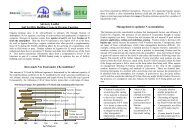A review of leguminous fertility-building crops, with particular ...
A review of leguminous fertility-building crops, with particular ...
A review of leguminous fertility-building crops, with particular ...
Create successful ePaper yourself
Turn your PDF publications into a flip-book with our unique Google optimized e-Paper software.
A <strong>review</strong> <strong>of</strong> <strong>leguminous</strong> <strong>fertility</strong>-<strong>building</strong> <strong>crops</strong>, Defra project OF0316 Executive Summary<br />
similar effect to intercropping, presumably because <strong>of</strong> a greater demand for soil-N under the<br />
denser crop.<br />
Transfer <strong>of</strong> fixed N can be substantial in grass/clover mixtures. There is a high turnover <strong>of</strong><br />
roots and nodules <strong>of</strong> living clover and greater opportunity for transfer to occur through<br />
decomposition and mineralisation pathways than in annual <strong>crops</strong>. In contrast to grass/clover<br />
swards, evidence <strong>of</strong> N transfer between other legume species and companion <strong>crops</strong> is <strong>of</strong>ten<br />
conflicting.<br />
Knowledge <strong>of</strong> relative rates <strong>of</strong> fixation at different seasons and stages <strong>of</strong> growth is important<br />
for assessing how much <strong>of</strong> this annual total is fixed by legumes that are grown for less than a<br />
full year, for example, <strong>with</strong> short-term cover <strong>crops</strong> or where a ley is cultivated during<br />
summer or early autumn. Relative rates <strong>of</strong> fixation in grass/clover swards are largely<br />
determined by temperature and moisture supply. The stage <strong>of</strong> vegetative or reproductive<br />
growth may be more important for annual grain legumes. For perennial legumes, longer-term<br />
fluctuations in factors such as soil mineral-N contents will also influence fixation.<br />
As would be expected from the previously described relationship between the build-up <strong>of</strong><br />
soil-N and N-fixation, fixation in grass/clover swards is also likely to decline <strong>with</strong> increasing<br />
pasture age (independently <strong>of</strong> changes in the proportion <strong>of</strong> clover).<br />
Influence <strong>of</strong> management<br />
Various aspects <strong>of</strong> management will influence the quantity <strong>of</strong> N provided by a legume crop.<br />
Effects can be divided between those, such as crop removal, which influence the net<br />
accumulation <strong>of</strong> N and those that influence the N-fixation process directly. Harvesting <strong>of</strong><br />
forage or grain will remove much <strong>of</strong> the fixed N and reduce the benefit to following <strong>crops</strong>.<br />
The benefit will be further reduced if straw and other crop residues are also removed from<br />
the field. In contrast, where <strong>crops</strong> are mulched or grazed, much <strong>of</strong> the fixed N will be<br />
returned to the soil in plant debris or excreta. Nitrogen-fixation processes will be affected<br />
directly by defoliation <strong>of</strong> the legume and indirectly through effects on the mineral-N content<br />
<strong>of</strong> the soil. Other aspects <strong>of</strong> management affecting N-fixation include position <strong>of</strong> the crop in<br />
the cropping rotation, duration <strong>of</strong> cropping, methods <strong>of</strong> cultivation and applications <strong>of</strong><br />
manures and composts.<br />
Cutting and mulching can result in mineral N accumulation, which will reduce fixation. It<br />
may be better to remove the foliage from the field, though this then requires the foliage to be<br />
managed (presumably as forage and, ultimately, as manure). In a mixed sward, decreasing<br />
the cutting frequency could potentially decrease fixation (increased competition from the<br />
grass), but defoliation <strong>of</strong> forage legumes also causes a dramatic decrease in N-fixation<br />
activity.<br />
Nitrogen dynamics are likely to be very different where the cut herbage is returned to the<br />
soil. However, there is little information about the direct effects <strong>of</strong> mulching on the Nfixation<br />
process.<br />
Harvesting <strong>of</strong> forage <strong>crops</strong> or <strong>of</strong> grain legumes both remove fixed-N from the field.<br />
Although N accumulated in stubble and roots will remain, the net contribution to the soil N<br />
balance may be small or even negative, <strong>particular</strong>ly <strong>with</strong> grain legumes which generally<br />
obtain a smaller proportion <strong>of</strong> their N from the atmosphere. The benefits will be even less if<br />
straw or other crop residues are removed as well as the grain.<br />
Written by S Cuttle, M Shepherd & G Goodlass Page 6




